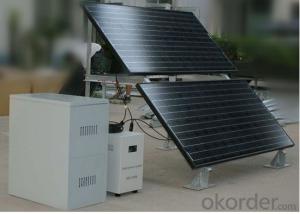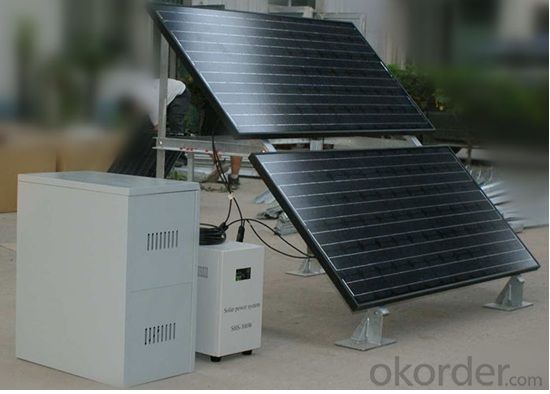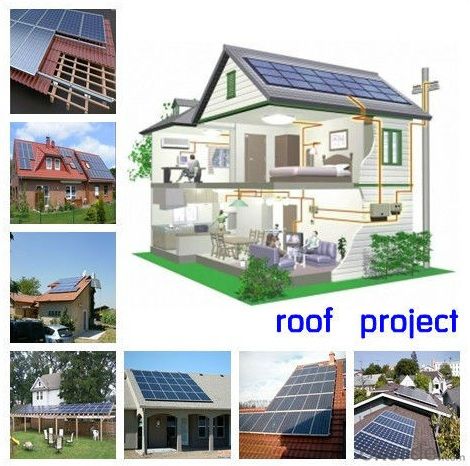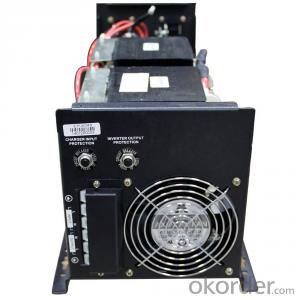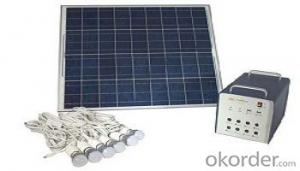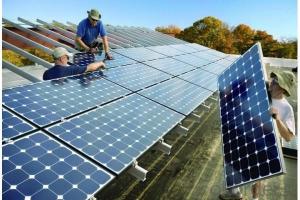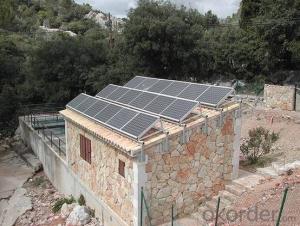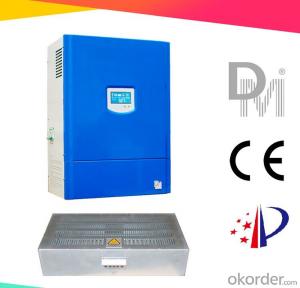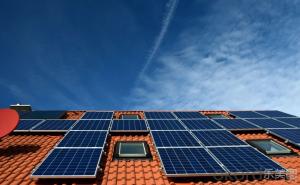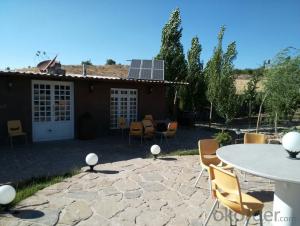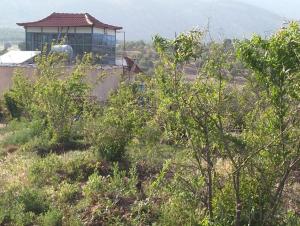Gaia for Solar Energy Systems:Off-Grid Power System/Solar System 2kw New
- Loading Port:
- Shanghai
- Payment Terms:
- TT or LC
- Min Order Qty:
- 2000 watt
- Supply Capability:
- 200000 watt/month
OKorder Service Pledge
OKorder Financial Service
You Might Also Like
| Packaging & Delivery | |
| Packaging Detail: | carton pallet |
| Delivery Detail: | within 7 days |
| Specifications | |
| 2KW Solar Power System | |
| Lifespan >20 years | |
| Designed to meet the needs for low power household appliances | |
| Base on your situaion ,we design the solar power system as following : | |
| 1: PV-system DC voltage level: DC 48V ,ouput AC voltage level: AC220V 50/60HZ | |
| 2: load Working time every day: 840W 5hours(3.5-4.2KW*h/day) | |
| 3: Primise rainy days: 2 days | |
| 4:PV system power Max Input Power: 2KW/DC72V Max AC Output Power: 2000W AC220V 50/60HZ,opration output power:inductive load <=1KW Resistive load:1.6KW | |
| 5: PV Array specification: Voc:DC86.4V Vmp:72V Isc:30A Imp:27.8A | |
Features:
1.Environmental protection
2.Energy-saving products
3.Portable
4.easily use
Advantages:
1.Safety and easy installation,Plug and play systems;
2.Good quality panel to ensure the high efficiency and long life needs;
3.Solar Automatic lighting controller :with adjustable run times, over-current protection;
4.Solar Batteries: Maintenance free, long life batteries
5.Lighting Source: LED lamp /Lantern (Fixed/Movable)
7.Flexible designs per client requests;
Using of scope:
It is very good for indoor use where there is shortage of electricity and for outdoor activities such as picnicking, fishing and camping. It is an ideal tool for Motor Mechanics, Farm House and small shop owners such as Hairdressers, Barbers, Cobblers, Tailors and Kiosk keepers.
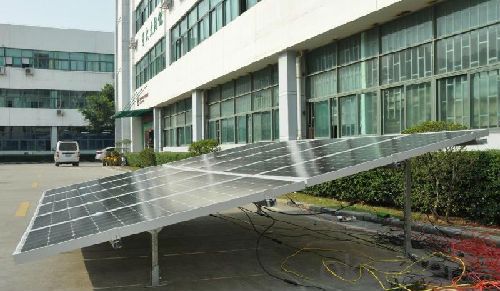
| Name | Type | Number | Remarks |
| MONO-Solar panel | JX200M/36V 1580*808*35mm | 10 | 2KW connection: 2 Series, 5 In parallel |
| Battery | 12V200Ah | 8 | Gel batteries The total capacity:DC48V/400Ah |
| PV-inverter | JX-2KW | 1 | inputDC48V -outputAC220V 50/60HZ,city power automatic switch |
| PV support | JX-S200-10 | 1 | 10 Pcs solar panels use a PV support , Material: Hot -dip galvanized |
| Battery box | JX-C24 | 1 | size:780*800*900mm 4layerdetachable type |
| PV Controller | CM4860 | 1 | DC48V 60A , RS485 communication function |
| PV cable,connect bettwen | PV-1*4.0mm2 | 100 | PV -specific single-core copper 4.0 mm2 cable,Double protection cover 100M |
| Power cable | BVV-1*16mm2 | 50 | single-core copper 16 mm2 cable,Double protection cover |
FAQ
We have organized several common questions for our clients,may help you sincerely:
①what price for each watt?
it depends on the quantity, delivery date and payment terms,
②what is your size for each module? can you tell me the parameter of your module?
we have different series of panels in different output, both c-si and a-si. please take the specification sheet for your reference.
③Can you provide the peripheral products of the solar panels, such as the battery, controller, and inverter? If so, can you tell me how do they match each other?
Yes, we can, we have two companies for solar region, one is CNBM International, the other is CNBM engineering Co.
We can provide you not only the solar module but also Solar Cells, the off grid solar system, we can also provide you service with on grid plant.
④What is your warranty system?
Our product performance guarantees for 25 years
• 12 years guarantee for workmanship
• Timeliness of delivery
• Quality Products certified (TÜV, UL, CE, ISO)
⑤How do you pack your products?
We have rich experience on how to pack the panels to make sure the safety on shipment when it arrives at the destination.
⑥ Can you do OEM for us?
Yes, we can.
⑦How long can we receive the product after purchase?
In the purchase of product within three working days, We will arrange the factory delivery as soon as possible. The pecific time of receiving is related to the state and position of customers. Commonly 7 to 10 working days can be served.
- Q: Do solar energy systems require regular inspections?
- Yes, solar energy systems do require regular inspections to ensure their proper functioning and efficiency. Regular inspections help identify any potential issues, such as damage, malfunctioning components, or reduced energy production, which can be addressed and resolved promptly to maintain the system's performance and longevity.
- Q: What are the components of the solar photovoltaic system?
- Frame: aluminum alloy frame with high strength, strong resistance to mechanical impact. Is also the most valuable part of home solar power. A device for converting direct current into alternating current. Since the solar cells and batteries are DC power, while the load is AC load, the inverter is essential. The inverter can be divided into independent operation inverter and grid connected inverter. The independent operation of the inverter is used for the independent operation of the solar cell power generation system, for independent load power supply. Grid connected photovoltaic power generation system for grid connected operation. The inverter can be divided into square wave inverter and sine wave inverter according to the output wave type. The square wave inverter has the advantages of simple circuit, low cost, large harmonic component, and the utility model can be used for a system with a few hundred watts and a low harmonic requirement. Sine wave inverter is expensive, but can be applied to various loads.
- Q: How do solar energy systems impact the reliability of the electrical grid?
- Solar energy systems can have both positive and negative impacts on the reliability of the electrical grid. On the positive side, solar energy systems can enhance the reliability of the grid by diversifying the sources of electricity generation. Traditional power plants heavily rely on fossil fuels, which are finite and prone to price volatility. By integrating solar energy systems into the grid, we can reduce the dependence on fossil fuels and increase the share of renewable energy sources, which are typically more stable and sustainable. Additionally, solar energy systems can improve grid reliability by decentralizing power generation. Traditional power plants are usually centralized, which means that a disruption at one facility can lead to widespread blackouts. In contrast, solar energy systems are typically distributed across various locations, which reduces the risk of a single point of failure and enhances the overall resilience of the grid. However, solar energy systems also pose certain challenges to grid reliability. One of the main concerns is the intermittent nature of solar power generation. Solar panels only produce electricity when exposed to sunlight, which means that their output can fluctuate throughout the day and is completely absent during nighttime. This intermittency can create challenges in matching the supply and demand of electricity in real-time, potentially destabilizing the grid. To address this issue, grid operators need to implement effective energy storage solutions, such as batteries, to store excess solar energy during peak production periods and release it during periods of low or no solar generation. Additionally, advanced forecasting and grid management technologies can help predict and balance the intermittent nature of solar energy, ensuring a reliable and stable electricity supply. In conclusion, while solar energy systems can enhance the reliability of the electrical grid by diversifying energy sources and decentralizing power generation, their intermittent nature poses challenges that need to be addressed through energy storage and efficient grid management techniques. Overall, with proper planning and integration, solar energy systems can contribute to a more reliable and sustainable electrical grid.
- Q: Can solar energy systems be used in powering street cameras or surveillance systems?
- Street cameras and surveillance systems can indeed be powered by solar energy systems. Solar energy is a reliable and independent source of power that is sustainable and renewable. To utilize solar energy, one can install solar panels on rooftops or mount them on poles near the cameras. These panels capture sunlight and convert it into electricity, which can then be stored in batteries. This stored electricity can be used to power the cameras and surveillance systems even when sunlight is scarce or at night. By utilizing solar energy for street cameras and surveillance systems, we not only reduce our reliance on traditional power sources but also contribute to reducing carbon emissions and minimizing our overall environmental impact. Moreover, solar-powered systems prove to be cost-effective in the long run as they eliminate the need for expensive cabling and provide a self-sustaining energy solution. In conclusion, solar energy systems are an excellent choice for powering street cameras and surveillance systems due to their sustainability, reliability, cost-efficiency, and environmental friendliness.
- Q: How long do solar energy systems typically last?
- Solar energy systems typically last for about 25 to 30 years.
- Q: What is the role of solar energy systems in promoting sustainability?
- Solar energy systems play a crucial role in promoting sustainability by harnessing the abundant and renewable energy from the sun. By generating electricity without relying on fossil fuels, solar power helps reduce greenhouse gas emissions and mitigate climate change. Additionally, solar energy systems contribute to energy independence, as they can be deployed on rooftops or in remote areas, reducing the need for long-distance transmission lines. Moreover, solar power has economic benefits, creating jobs and stimulating local economies. Overall, solar energy systems are a key component in transitioning to a more sustainable and clean energy future.
- Q: What is the role of inverters in solar energy systems?
- The role of inverters in solar energy systems is to convert the direct current (DC) electricity generated by the solar panels into alternating current (AC) electricity, which can be used to power homes, businesses, and other electrical appliances. Inverters also ensure that the AC electricity produced matches the frequency and voltage requirements of the electrical grid, enabling seamless integration and distribution of solar power.
- Q: What is the impact of solar energy systems on air quality?
- Solar energy systems have a positive impact on air quality as they produce electricity without emitting harmful pollutants or greenhouse gases. By reducing the reliance on fossil fuels, solar energy helps to mitigate air pollution, improve public health, and combat climate change.
- Q: Can solar energy systems be used in areas with limited resources?
- Yes, solar energy systems can be used in areas with limited resources. Solar energy is a renewable and abundant source of power that can be harnessed even in remote or underdeveloped regions. The installation and maintenance costs of solar systems have significantly decreased over the years, making them more accessible to communities with limited resources. Additionally, solar energy systems can provide electricity and heat without relying on external fuel sources, reducing the dependence on expensive imports. Overall, solar energy offers a sustainable and viable solution for areas with limited resources, helping to meet their energy needs and enhance their socio-economic development.
- Q: How do solar energy systems impact the overall sustainability of a home?
- A home's overall sustainability is significantly affected by solar energy systems. To begin with, these systems greatly reduce reliance on finite fossil fuels, which contribute to climate change. By harnessing the sun's power, solar energy systems generate clean, renewable electricity that is free from harmful emissions and pollutants. This not only helps combat climate change but also enhances air quality in the surrounding environment. Additionally, solar energy systems grant homeowners energy independence and resilience. By generating their own electricity, homeowners can reduce their dependence on the grid and avoid fluctuations in energy prices. This leads to long-term cost savings and improved financial stability. Moreover, during power outages or natural disasters, solar energy systems equipped with battery storage offer a reliable source of electricity, ensuring vital appliances and systems continue to function. Furthermore, solar energy systems enhance a home's energy efficiency. By supplementing or replacing traditional energy sources, these systems decrease overall energy consumption in a household, resulting in reduced utility bills and resource conservation. Moreover, the installation of solar panels can boost a home's value. As renewable energy becomes increasingly popular and desirable, potential homebuyers are more willing to pay a premium for properties equipped with solar energy systems. This benefits not only homeowners looking to sell their homes but also contributes to the overall growth and adoption of sustainable energy solutions. Lastly, solar energy systems foster a sense of environmental stewardship and sustainability. By utilizing renewable energy, homeowners actively contribute to reducing their carbon footprint and preserving the planet for future generations. This commitment to sustainability extends beyond the household, inspiring others to embrace clean energy and work towards a greener future. In conclusion, solar energy systems have a wide-ranging and positive impact on a home's overall sustainability. They diminish reliance on fossil fuels, enhance energy efficiency, provide energy independence and resilience, increase property value, and promote environmental stewardship. By harnessing the sun's power, solar energy systems pave the way for a more sustainable and resilient future.
Send your message to us
Gaia for Solar Energy Systems:Off-Grid Power System/Solar System 2kw New
- Loading Port:
- Shanghai
- Payment Terms:
- TT or LC
- Min Order Qty:
- 2000 watt
- Supply Capability:
- 200000 watt/month
OKorder Service Pledge
OKorder Financial Service
Similar products
Hot products
Hot Searches
Related keywords
